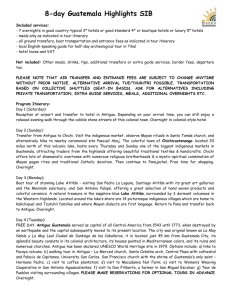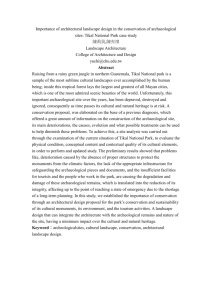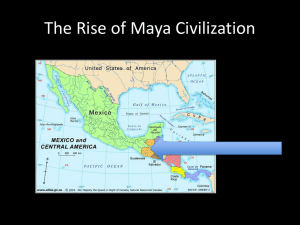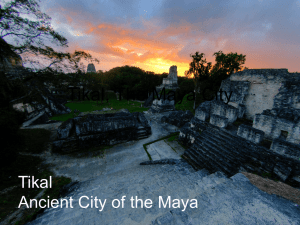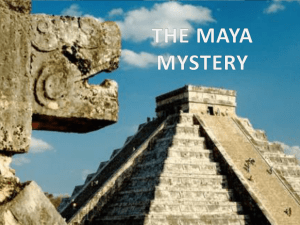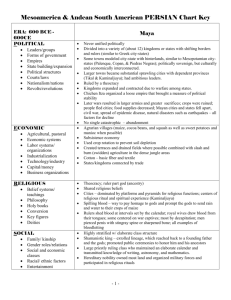Geography Case Study Outline:
advertisement
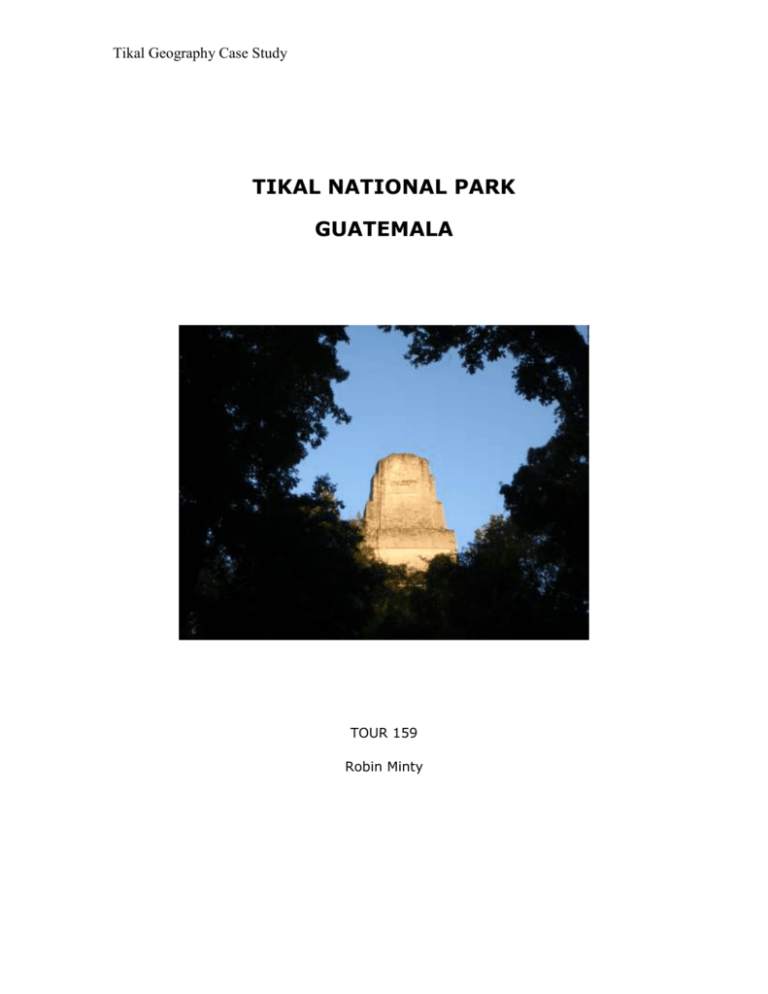
Tikal Geography Case Study TIKAL NATIONAL PARK GUATEMALA TOUR 159 Robin Minty Tikal Geography Case Study Contents Executive Summary: ........................................................................................................... 3 Introduction: ........................................................................................................................ 4 Tikal Description: ............................................................................................................... 4 Physical Geography: ....................................................................................................... 4 Human Geography: ......................................................................................................... 4 Destination experience: ................................................................................................... 5 Interesting Issues:............................................................................................................ 6 Opportunities & Challenges ................................................................................................ 6 Environmental Changes: ................................................................................................. 7 Economic Changes: ........................................................................................................ 8 Socio- Cultural/ Political Changes: ................................................................................. 8 Conclusion& Final Critical Overview: ............................................................................... 9 References: ........................................................................................................................ 10 Tikal Geography Case Study Executive Summary: The site of Tikal’s unique advantage of being recognized as a World Heritage Site has had positive impacts from tourism. Tourism preserves cultural values, natural resources and the environment. The ancient city structures have been protected by the country of Guatemala since 1955 as Tikal National Park (“La Casa”, 2009.) The protection ensures minimal damage to the habitats of the wildlife and to the site. The impacts from the resignation of being a World Heritage site have created a favorable image for Tikal and Guatemala. The country has a reputation of being unsafe because of the high internal conflicts that occur between the citizens. Tikal has gained worldwide interest, economic value and local pride which all help recreate the image of Guatemala. The indigenous communities around Tikal have had the greatest impact from tourism. These cultures live in seclusion and still live off the land the same way their ancestors did. The laws protecting the natural environment of the park prohibits these communities from accessing resources that have been vital to their way of life for centuries. Poaching and hunting are illegal practices in the park which has negative implications on the people who depend on the food for survival. The aim of tourist companies that developed Tikal was to create a Heritage Cultural Experience in a non intrusive, sustainable manner. The fact that there are three hotels with pools in the middle of the rainforest makes conservational ecotourism in Tikal a controversial subject. These companies must revisit their goals and objectives in order to maintain the site as a place of universal significance. Ways to prohibit too many visitors into the area would be to charge a higher visitor fee or limit the tourist season. If Tikal becomes more inaccessible, only those truly determined to visit the site will make it to witness this remarkable place. Tikal Geography Case Study Introduction: Deep in the wild rainforest the sight of an ancient city emerges through the trees. The peaks of magnificent temples protrude through the mist from up above. Tikal is the first established World Heritage site as recognized by the United Nations Educational Scientific Cultural Organization (“Petén department”, 2009.) The fragile urban cultural landscape is located in Northern Guatemala; bordering Mexico to the North and Belize to the East (“Tikal National Park”, 2009.) The site is part of the Tikal National Park and is part of the Mayan Biosphere Protected Parks Area. The abandoned city of the Mayan people is full of mystery and is rich with ancient history. For thousands of years the Mayan community lived in mythical temples and became one of the most technologically advanced cultures in history. The Mayan establishment collapsed in the 10th century and archeologists, scientists and researchers have yet to discover why (“UNESCO”, 2009.) At the end of the 18th century, Tikal’s existence started to gain global interest and the site is still being excavated today (“Destination 360”,2009.) Journalists, photographers and tourists trek to the site from all over the world to witness the astounding manmade structures and learn more about this powerful culture and its demise. Tikal became a National Park in 1955 and regulations and borders were defined (“La Casa”, 2009.) In 1979, as tourism developed, the World Heritage Committee announced that there was a need to protect the ruins at Tikal and the natural environment. Sustainable tourism and conservation have been the main goals of the Committee since then (“World Heritage Center”,2009.) Tikal Description: Physical Geography: Tikal is located in the Petén region of Guatemala which is characterized by rainforests, swamps and limestone ridges (“Tikal National Park”, 2009.) The dense subtropical rainforest contains over 200 species of trees and is home to over 100 species of mammals, reptiles and amphibians. The climate is hot, sunny, humid and wet. There is no clearly defined dry season and the average rainfall is 1, 945mill (“Tikal National Park”,2009.) Human Geography: Mayans have survived in the Petén region for 2 millennia by surviving off the land using intensive agricultural techniques (“Classic Maya Collapse”, 2009.) The Classic Mayan collapse refers to the decline in population and abandonment of classic Mayan cities such as Tikal. There are eighty- eight different theories and the actual reason for the collapse has yet to be discovered (“Classic Mayan Collapse”, 2009.) One of the most widely accepted theories comes from evidence of drought, famine and decline in land fertility (“Classic Mayan Collapse”,2009.) This presents challenges for conserving the area today as the land is highly susceptible to drought phases and climatic changes. The history that has been uncovered in exploring Tikal has brought about scientific breakthroughs that benefit the global community as well as the local regions ("Classic Maya Collapse”, 2009.) Indigenous communities rely on agriculture, fishing, forest dwelling and hunting & gathering to survive. They follow some sustainable practices such as burning grazing areas to regenerate land. Since Tikal National Park was established, these communities have been cut off from the necessary resources that they require to survive. New economic practices have had to be Tikal Geography Case Study developed and tourist companies work with the locals to ensure they remain sustainable without relying on resources in the natural environment to provide them with food and shelter (“UNESCO”, 2009.) Guatemala is a country with wide income disparities and tourist destination facilities are generally good. A 36- year armed conflict ended in 1996 with the signing of the Peace Accord. Violent crime, an abundance of weapons and dysfunctional law enforcement and judicial systems are still concerns for safety. Approximately 3,000 guerillas have been demobilized and the government is working to integrate them back into society. Poverty is a huge issue for the country and problems arise in participation from the locals and economic opportunities (“Guatemala safety”, 2009.) Destination experience: Tikal’s main attraction is the ancient city of the Mayan community’s culture which was abandoned in the 10th century AD. Tourism to Tikal changed forever in 1951 with the development of an airstrip; the once inaccessible site was transformed into a major tourist destination. Flores, the closest city in proximity is now the gateway to Tikal and the site of the international airport. Tourists can stay in a nearby city, tour as a group through Guatemala, Mexico and Belize, or stay at the actual site inside the National Park (“Tikal National Park”, 2009. The National Park covers over 200 square miles and contains three hotels, four restaurants, two museums, two pools, tour guides, an information booth, a gift shop and interpretive services (“Destination 360”, 2009.)Guests can rough it in the campground overnight or choose from a variety of lodging options. The three large hotels promote their close proximity as being beneficial to beating the tourist rush that other tourists have to deal with who stay outside the park (“Destination 360”, 2009.) According to Butler’s tourist model, Tikal is in its development phase of growth (Williams, 2008.) The site is attracting inward investment which increases the external control and it is acquiring more sophisticated infrastructure. New structures now intertwine with the ruins so that tourists can climb to the top and get a full interactive experience. The rapidly expanding clientele from a wide market is also a characteristic of this phase. Cohen’s tourist typology framework provides meaningful insight to the type of tourist attracted to Tikal. According to Cohen, the first tourists to Tikal were Drifters and Explorers which are categorized as seeking to immerse themselves in host cultures and systems (Williams, 2008.) These pioneers in the 1840’s were the first people to discover Tikal and were seeking to obtain self actualization and knowledge of the ancient Mayan community (Tikal National Park.) The pattern of growth since then has transformed the type of visitor into an Organized Mass Tourist seeking leisure travel and having significant detrimental impact on the site. The sense of place at Tikal varies between tourists. Early tourists would have a profoundly different sense of place than tourists who visit today. Drifters and Explorers were exposed to the site through tangled rainforest after an adventurous trek. With no supporting amenities, the site was secluded from the outside world and a peaceful, spiritual sense of place probably evolved. The Organized Mass Tourists that see the sites today are able to relax in the comfortable hotel rooms, swim in pools and might find the trails too strenuous and long. The sense of place has been distorted but Tikal can remain a peaceful, spiritual place of mystery for some. Tikal Geography Case Study Interesting Issues: The advanced Mayan culture and their calendars and knowledge of astronomy led them to predictions that the world as we know it will end on approximately Dec. 21 st, 2012 (“The Mayan Prophecy”, 2009.) As the date approaches, a worldwide interest could ensue and the site could become more populated with visitors trying to relieve their curiosity. This would change the type of tourists that would visit the area as they will all by trying to obtain some type of self- actualization. A shift could be observed and Tikal might once again attract Explorers seeking a cultural and ancient heritage experience. As ecotourism and sustainable tourism practices are better implemented, the site could become more economically and environmentally beneficial to the local community. Opportunities & Challenges The ancient site is globally recognized as being important enough to protect and this must be effectively communicated to all stakeholders involved for policies to be successful. Clear rules regarding environmental and safety issues must be expressed and properly implemented. A fulfilling and satisfying experience from visitors needs to be achieved so the site generates revenue for the local community. Most importantly, the surviving Mayan communities must be involved and understand the rules and regulations to avoid future conflict while at the same time being able to exert some level of control over their own environment. At the trail head a large sign posting specific rules is posted for visitors to the site of the ruins (Figure 1): Figure 1: Tikal Site Sign Rules and Regulations (Minty, 2008) Tikal Geography Case Study Environmental Changes: Tikal was vulnerable to destruction before it became a National Park. Tikal’s masterpieces of human created genius are protected as a World Heritage Site representing many of the key requirements of the status recognition. The hot climate can pose problems of dehydration and exhaustion for tourists. Tourism helps to educate visitors from their respective countries on the nature of conservation and protecting the environment (“Tikal National Park”, 2009.) Physical carrying capacity is an important concern for the landscape and value of the National Park. Linking Biodiversity and Sustainable Tourism is a goal for World Heritage sites (“World Heritage Center”, 2009.) Thousands of dollars have gone into implementing programs that will benefit the locals and conserve the environment for future generations to enjoy. Activities involve planning, monitoring the site and conservation costs, training programs for local residents, policy recommendations and information sharing (“World Heritage Center”, 2009.) Non invasive activities are promoted such as hiking, kayaking and biking around the park (“Tikal National Park”.) Training on monitoring biodiversity within the park and workshops to lead tours has helped the locals gain skills necessary to earn an income from tourism. Government planning and local involvement has defined public use areas to conserve the environment and address issues regarding extraction of wildlife (“World Heritage Center”, 2009.) The public use areas help the tourists conserve the environment by staying on designated paths and signs are posted with clearly defined rules for the site. Tikal covers a vast area of jungle and new ruins and artifacts are still undiscovered. There is still an element of surprise and mystery to keep visitors coming back to the site and pursue their own personal research. This can be damaging to the natural environment as tourists wander away from assigned pathways. The mere presence of tourists affects the wildlife in the area and can change their natural patterns. The environment is susceptible to damage over time. Physically, the ruins are slowly eroding and the protected areas around the site are in constant danger of forest fires (“UNESCO”, 2009.) The National park has been declared a vulnerable area and threats include the illegal extraction of natural resources and poaching. This is occurring because of lack of respect from individuals as well as lack of staff to monitor and guard the entire park (“Tikal National Park”, 2009.) There are issues with dehydration so accessible drinking water is important. When it rains, trails can become wet and muddy. The canopy provides decent shade when the sun is intense and there are benches around the site so that tourists can rest. Unfortunately, there is limited access for disabled visitors as most of the views are enjoyed from the tops of steep, narrow, wooden staircases. Tikal is situated on high ground and there is evidence that finding suitable drinking water was an issue, they relied mostly on rainwater reservoirs. If rain didn’t come they faced drought and dehydration (“Tikal National Park”, 2009.) Education on the environmental issues of Tikal is the best way to help the destination stay sustainable. It is stated that illegal extraction of natural resources and poaching are a constant problem but it is the Indigenous tribes committing theses “crimes” which before were common practices on their own land. With enough information accessible to the public and capacity limits implemented properly, the environment can maintain intact for future generations. It is the indigenous community who runs the risk of losing their culture and identity as globalization changes the way they survive forever. Tikal Geography Case Study Economic Changes: Tourism has proven to be beneficial to the local Mayan community. Profits and total sales have risen in the past few years since new conservation views have been implemented (“World Heritage Committee”, 2009.) Local community members recognized the value in Tikal and have been marketing the experience to travelers seeking knowledge on the region from local experts. Conservation Tours Tikal and Rare are two tourism companies that work to educate the locals on the importance of tourism and provide them with sustainable economic alternatives through training in a vast market (“UNESCO”, 2009.) A financial report from the Conservation Tours Tikal shows that almost all start up costs for the company had been recovered and 90% of revenues were retained in the local economy (“UNESCO”, 2009.) A few challenges are in obtaining investment for new equipment and a vehicle. Conservation Tours Tikal has trained locals to work in the economic field while informing them on the importance of finding sustainable alternatives to suit their well being. Guatemala as a country is in its developing phase of tourism. Conservation Tours Tikal has used its niche marketing to attract customers looking for authenticity in an ever growing commercial market. The company donates 10% of the profits earned just into clean up campaigns and environmental education programs in rural schools (“UNESCO”, 2009.) The company benefits the community as a whole by supplying jobs and showing community members the importance of education. As the tourist destination of Tikal grows and receives a positive global image, the country benefits as well. Socio- Cultural/ Political Changes: The country’s culture blends the old with the new and more than half of the population is from Mayan descent (“Soul of the Earth”, 2009.) In urban areas, culture is modeled after European and North American trends while indigenous people following traditional practices inhabit rural communities (“Soul of the Earth”, 2009.) This division between the rich and the poor has imbalanced the country for centuries and has caused much internal conflict. The indigenous community remains isolated from the outside world and although they live in poverty standards, their lifestyle is economically and spiritually satisfying (“Soul of the Earth”, 2009.) In 1996, Peace Agreements were implemented to protect these people from government suppression (“Soul of the Earth”, 2009.) The invasion into the territory of the indigenous communities has disrupted their way of life. Tikal was vulnerable to destruction before it became a National Park. Tikal’s masterpieces of human created genius are protected as a World Heritage Site representing many of the key requirements of the status recognition. Cultural preservation and environmental restoration have been positive results of tourism. Guatemala’s Tourism Commission presented the new image as the “Soul of the Earth” and created a favorable world image for the destination (“Soul of the Earth”, 2009.) Mysticism, diversity, evolution and authenticity were identified as the country’s core values for tourism (“Soul of the Earth”, 2009.) The goal of the Commission is to increase international tourism by providing information on the diverse geographic, historic, cultural and natural characteristics of the country (“Soul of the Earth”, 2009.) Guatemala is a highly affordable country to visit; food, lodging and transportation is inexpensive for all types of travelers. However, Canadians should exercise a high degree of Tikal Geography Case Study caution as instances of violence, crime, roadblocks, demonstrations and protests can occur (“Foreign Affairs”, 2009.) The site of Tikal in particular is susceptible to protests, car hijackings, civil unrests and robbery (“Foreign Affairs”, 2009.) Security guards help to lessen the impact of danger but the physical man power needed is hard to maintain. Prevention is the most important solution and tourists should consult a travel warnings website before visiting Guatemala to avoid safety issues. More than half the population is from Mayan descent and so the Tikal site holds significant importance for the country. However, the National Park of Tikal isn’t effectively guarded and those opposed to the existence of the park vandalize the area and start fires with no fear of consequence. In emphasizing the importance of protecting Tikal and the indigenous communities in the area, global pride and recognition can help Guatemala to unite as a country towards one common goal. Conclusion& Final Critical Overview: The locals are benefitting from the number of visitors as the multiplier affect plays out but the carrying capacity isn’t going to hold up forever. Criminal activity is common and monuments are being purposefully destroyed. In order for Tikal to stay sustainable, cultural heritage should be strongly promoted so that visitors recognize the need to respect the site and the artifacts. In order to preserve the National Park environment and the historical value of the ancient city, stronger regulations and capacity limits need to be enforced. Tourism plays an important role in protecting the destination but it also has a negative effect on the indigenous tribes who have been exposed to the zoo that is mass tourism. The environment also suffers as tourism grows but the wildlife and resources are also nationally protected and can be preserved if stronger rules are enforced. Tourism companies need to be responsible and leave no trace or footprint in the area and they can actually contribute to the problem. Tikal is a significant display of human genius and creativity and can inspire people today to use their knowledge and exert it towards a greater world. Tikal Geography Case Study References: (2009) Peten Department. Retrieved from http://en.wikipedia.org/wiki/Pet%C3%A9n_(department) (2009) Destination 360 http://www.destination360.com/central-america/guatemala/tikal. (2009) Tikal National Park. Retrieved from http://en.wikipedia.org/wiki/Tikal_National_Park (2009) Classic Mayan Collapse http://en.wikipedia.org/wiki/Classic_Maya_collapse (2009) World Heritage Center http://whc.unesco.org/en/activities/66/ (2009) Foreign Affairs and International Trade Canada http://www.voyage.gc.ca/countries_pays/report_rapport-eng.asp?id=112000 (2009) UNESCO http://whc.unesco.org/en/activities/71/ (2009) Guatemala Safety http://www.globalsecurity.org/military/world/war/guatemala.htm (2009) The Mayan Prophecy http://www.december212012.com/M-The_Mayan_Prophecy.htm (2009) Soul of the earth http://www.mazalien.com/soul-of-the-earth.html (2009) La Casa http://www.lacasadedondavid.com/tikal.html Stephan Williams, (2009). Tourism Geography: A New Synthesis. New York, NY: Routledge. Tikal Geography Case Study

